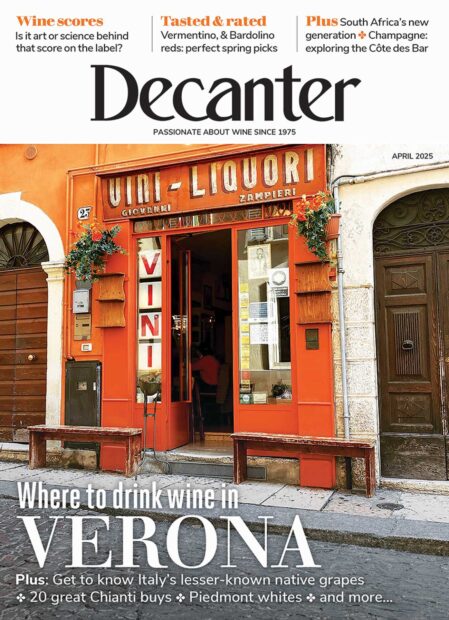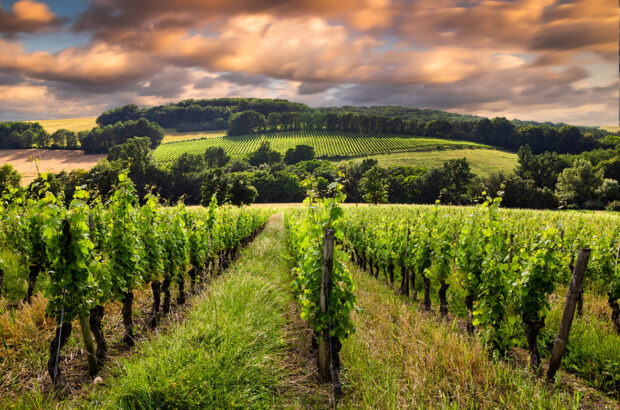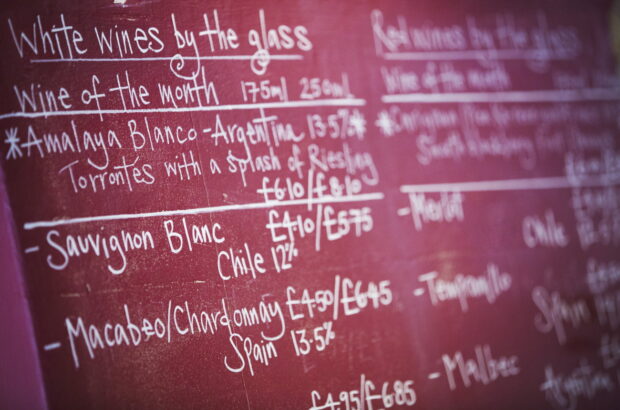I started to write my thoughts on the vintage as the dust settled from the annual primeur’s week (or month in my case) and when my teeth and lips had finally lost their purple hue – an unsightly image I documented once on Instagram.
This year more than 7,000 eager wine tasters were welcomed onto the red carpets of various historic châteaux buildings, past manicured gardens and into beautifully decorated tasting rooms to taste the new batch of baby wines before tucking into lavish spreads, often with special wines and great cheese boards.
As one of my esteemed wine merchant friends wrote: ‘Primeurs is a circus and we’re part of the show.’ But what a show it is…

My month took me to dozens of châteaux and various group tastings sampling around 800 wines, as well as a few extremely glamorous gala dinners. One saw my inauguration into the Hospitaliers de Pomerol, pledging my support for the wines of the appellation, while another gave me the chance to taste a host of wines all ending in the number three, dating back to 1943 with a fabulous Doisy-Daëne.
The final event, the Fête du Bontemps, which concludes the official week, saw around 900 people in black tie attire dine inside the Smith-Haut Lafitte cellars before watching a spectacular fireworks show on the lawn.
A lot happens in April, and I’m extremely fortunate and grateful to live so close to the action.

Being inaugurated into the Hospitaliers de Pomerol
It’s also a chance to meet wine trade members from around the world – to get a feel for the market conditions in Korea or Switzerland, for instance, and see responses from buyers scouting out potential purchases for the UK or US. Price is always a concern, as in any year, but if anyone says primeurs has lost its lustre or lure, it hasn’t.
Each critic has their own schedule and formula. I like to start on the right bank with consultant tastings: Derenoncourt in Sainte-Colombe just outside of St-Emilion and Laboratoire Rolland et Associes in Pomerol. These cover almost 300 wines (red, white and sweet) and present a widespread overview of the vintage, from small names in outlying appellations up to grand cru classé estates.
I plan the larger Union des Grands Crus de Bordeaux (UGCB) and négociant tastings (Joanne and CVBG/Dourthe) in the middle, and finish with the left bank consultants Oenoconseil and Boissenot at the end, saving re-tastes and seeking out new properties for primeurs week itself.

Tasting at Château Lafleur
Each château has its own approach too, with some waiting for a specific date before showcasing their wines, mitigating school holidays, Easter weekend and bottling of their 2021s.
Many tastings outside of the official en primeur week need specific appointments, making the logistical efforts of planning around 80 separate visits rather strenuous. I need to consider how many wines there might be – it can vary between one and up to 20 – so visits can last anywhere from 30 minutes up to two hours. The time it takes to drive from one estate to the other needs factoring in, even the walk from the car park and to the tasting room can count. I prefer to group estates by appellation and plan tastings – left bank north to south, or right bank east to west finishing closest to Bordeaux. Time management during primeurs is a fine art.
Winemaker commentary on the vintage and the supplying of wine details and technical information is key. From specific yields and precipitation to alcohol, pH and IPT – the details count. How much press wine was used? When did the harvest start and finish? Will the oak regime be changed? What is the percentage of grand vin production? The booklets range from glossy and picture filled (lots of estates) to embossed cardboard plaques (Montrose) and keepsake ceramic ornaments with the blends of each wine painted on them (Gruaud-Larose).
An initiative started last year at Lafite presents particularly creative collectible cards displaying overviews of each wine with their own title. Carruades 2022, for instance, is L’Enfant Précoce – ‘the precocious child’ and the grand vin (pictured at the bottom) is ‘La Grand-Mére O.V.N.I. – the oddball grandmother, with an ageless quiet strength and incredible charm’.
Winery representatives, from owners and managers to oenologists, present the vintage discussing localised weather conditions, vineyard management, picking strategies, blending components, personnel changes, cellar improvements and new labels (Ch Tronquoy – dropping the Lalande and now in blue – below, Batailley with reference to the late-Queen Elizabeth II and Figeac now proudly displaying their upgrade to Premier Grand Cru Classé A in the new St-Emilion classification).

Tasting at Château Montrose
What fascinates me is that no two estates, even neighbours, describe the vintage the same: one may have decided to remove the cover crop to stop water competition with the vines, the other mulched the crop to retain moisture and keep the soils cool. One may have de-leafed on the morning sunshine side, the other will have instead just cropped the canopy shorter at the top to keep shade. One may qualify the amount of rain received, the other won’t mention it. The list goes on…
The overall message of ‘surprise’ and ‘success’ for 2022 coincidentally remains the same but, more closely, Bordeaux’s dynamism is alive and well, making this even more of an interesting time to be talking about the wines.
Some samples are bottled with labels – this year often in 35cl bottles given the smaller yields and desire to reduce waste (a whole barrel full of wine can be used for primeurs samples alone, with up to 2,000 guests registered at a single winery).

Tasting at Château Margaux
Coming soon: Our full Bordeaux 2022 verdict with en primeur scores and tasting notes
Join Decanter Premium for full access
Some were drawn directly from barrels, taking more of a Burgundian approach to proceedings at Châteaux Angélus and Rauzan-Ségla (below). Some are racked the morning of, others can be a day or two old (invariably beneficial for wines increasingly made over-reductively to avoid oxidation), many are the ‘final blend’, the rest are approximations. Some wines are decanted and a few are sent to my home address to taste at leisure.

Tasting from the barrel at Château Rauzan-Ségla with winemaker Nicolas Audebert
It’s an exhausting period and, even with anticipation, I didn’t expect to be so tired at the end of each day. Every wine requires such concentration and thoughtful note taking – despite the fact I will taste all these wines again before anyone else does, so do they really need to be so detailed, I asked myself. (Decanter’s chief copy editor says ‘definitely not!’). But this year, certainly more than last, the wines presented much more power, body and tannic strength rendering early palate fatigue.

The St-Emilion Grands Crus Classés tasting at Château Dassault
The exact number of wines I tasted is not so important, though it has spilled into the region of ‘too many’. In reality, a large proportion will not be sold as futures and it takes that much longer to write them all up. Given the current climate for petit châteaux and struggling smaller estates, I think tasting at a different time of the year outside of this process would give them more opportunity to shine.
I’d like to see more sommeliers come to the region and help get Bordeaux wines, at reasonable or even lower prices than retail, into more dining establishments around the world.
I also believe the UK government, post-Brexit, is making it prohibitive to import ‘good value’ wines into the UK. One merchant told me that no matter the quality of a €10-€15 ex-château bottle, it’s ‘just not worth it financially’ to get it into the country. Such a pity.
Stay tuned for the full list of Bordeaux 2022 notes and scores and news on releases as they happen. Already around 30 wines have been released with the first of the big-names – Château Cheval Blanc and Châteaux Angélus – released yesterday (9th May).
Read the Bordeaux 2022 en primeur: Vintage analysis and first thoughts post here
Bordeaux 2022 in pictures
Candid photos taken throughout April

Tasting at Château Cos d’Estournel

Barrel tasting at Château Angélus

Tasting the 2022s at Château Cheval Blanc

Tasting the range of 2022s at Château Ausone

Weather patterns at Château Haut Bailly in 2022

Tasting at Clos Fourtet

The keepsake card for Château Lafite Rothschild grand vin 2022

Tasting the range of 2022s at Château Batailley

Tasting Château Léoville-Las Cases 2022

Tasting Château Beauséjour Duffau-Lagarrosse 2022 with winemaker Joséphine Duffau-Lagarrosse

Tasting the 2022 with Marielle Cazaux, winemaker and general director of Château La Conseillante

Tasting Petrus 2022

Inside the Union des Grands Crus de Bordeaux tasting of the 2022s

The beautiful lawn at Château Branaire-Ducru

Tasting the range of 2022s at Château d’Issan

Tasting from the barrel at Château Rauzan-Ségla with winemaker Nicolas Audebert

Inside the Cru Bourgeois 2022 tasting

Winemaker Jean-Jacques Dubourdieu pouring Château Doisy-Daëne 1943

Tasting fine wines ending in 3 at the Académie du Vin dinner in Bordeaux

The new label showing the upgraded classification at Château Figeac

The Fête du Bontemps fireworks display at Château Smith Haut Lafitte

Tasting the 2022s at the Laboratory of Oeonology Rolland & Associates







